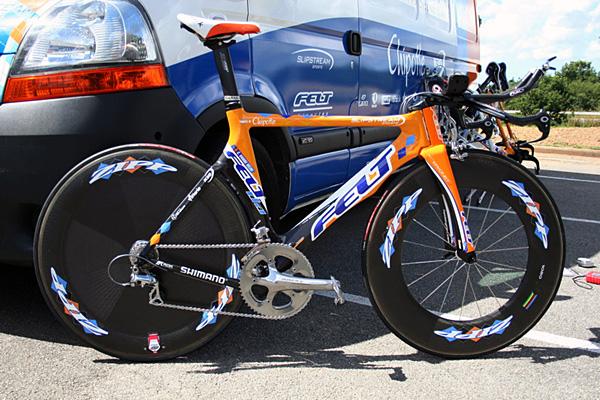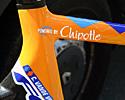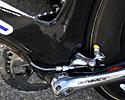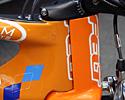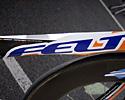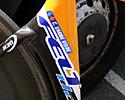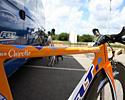
 |
 |
 |
 |
 |
 |
 |
 |
 |
 |
Pro bikes, July 26, 2008
Christian Vande Velde's Garmin-Chipotle Felt DA
Vande Velde's shot at the Tour podiumBy Ben Atkins After a long career selflessly working for riders like Lance Armstrong, Carlos Sastre and Fränk Schleck, a move to Garmin-Chipotle (then called Slipstream-Chipotle) for this season has given Christian Vande Velde's career a completely new direction. The 32-year-old from Lemont, Illinois was first to cross the line as the boys in argyle won the opening team time trial in this year's Giro d'Italia. As a result, Vande Velde also wore the first maglia rosa of the race and became the first American to do so since Andy Hampsten. Although he finished the Giro in 52nd place, a strong fifth place in the closing time trial confirmed his metamorphosis from super-domestique to stage race contender. That valuable experience at the Giro d'Italia - and the confidence of his team - brought Vande Velde to this year's Tour de France as a genuine GC hope. Indeed, Vande Velde put in a brilliant performance in the first time trial and sat within a minute of the maillot jaune through the entire second week, briefly occupying as high as third place overall. Unfortunately, a crash on the descent of the Cime de la Bonnette-Restefond on stage 16 cost him more than two and a half minutes on the rest of the favourites, effectively seeing an end to his bid for overall victory. Even so, Vande Velde's superb time trial ability might still put him atop one of those podium steps when the race wraps up on the Champs-Elysées on Sunday. Vande Velde will certainly hope that his Felt DA will earn him a bit of time as he makes his way along the rolling 53km-long course. Felt designed the slippery-looking frame using a mix of aerodynamic profiles developed by the US National Advisory Committee for Aeronautics, powerful computational fluid dynamics software and good old fashioned wind tunnel time. The result is a shape that Felt naturally claims is one of the fastest around. The DA bears the usual aero-profile down tube, seat stays and seatpost, and a deep cutout on the seat tube that closely follows the rear wheel. However, Felt also adds a similar cutout to the dropped down tube to help smooth airflow off of the front wheel. Conversely, the top tube is dead-level and relatively slender for minimal frontal area. Felt's Bayonet steering system is the real departure from the norm though, as the exceptionally deep fork legs blend into an extension that completely shields the head tube. The resultant combination effectively gives the front of the bike an aerodynamic 6:1 aspect ratio and cleverly skirts around the UCI-mandated 3:1dimension for an individual frame member. The 1"-diameter steerer tube keeps things especially narrow up front, too, while an adjustable stem is on hand to accommodate Vande Velde's aggressive position. Other clever details include a rear brake that is well concealed behind and above the bottom bracket area and well thought-out cable routing. Housings for the rear brake and both derailleurs enter the top of the frame behind the stem - where the air is already turbulent - and then exit as close to their final destination as possible to maintain the frame's clean lines. Garmin-Chipotle uses Zipp wheels throughout and its time trial machines are fitted with the fastest ones available from the Indianapolis, Indiana-based company. The Sub9 rear disc is claimed to be the first wheel to record negative drag in the wind tunnel while the 1080 front wheel wears an incredibly deep 108mm profile. In keeping with the team's aesthetic theme, even the wheels are decorated in Garmin-Chipotle's trademark argyle. Both wheels are fitted with 20mm-wide Vittoria Crono EVO-CS tubular slicks. Vande Velde's Oval Concepts A911 handlebar setup is also among the most radical around with their innovative JetStream technology. According to Oval, the twin airfoil design reduces drag by 4-6 percent over a single element design and the dropped grips are set very low on each side to keep Vande Velde low even when he's on the brakes. Vande Velde apparently prefers double bend extensions which, along with the rearwardly set elbow pads, are set decidedly narrow to cut through the wind. The entirely Shimano Dura-Ace groupset (aside from the Oval A900 carbon brake levers) includes a 175mm chainset with 55 and 44-tooth rings for the predominantly flat courses of this year's Tour. An 11-21-tooth cassette is all that's needed for the high speeds expected, and the Shimano theme continues with a pair of SPD-SL pedals. Vande Velde may be in good form and on a fast bike but what will happen on Saturday? A spot on the podium may still be a long shot but stranger things have happened in the Tour de France over the years. PhotographyFor a thumbnail gallery of these images, click here Images by Ben Atkins/Cyclingnews.com
| |||||
Full specificationFrame: Felt DA Critical measurements Brakes: Shimano Dura-Ace BR-7800 with SwissStop Yellow King
pads |
Front wheel: Zipp 1080 Bars: Oval Concepts A911 Jetstream Custom Aero Bar with A900
Carbon Double Bend extensions, 38cm (c-c) Pedals: Shimano Dura-Ace SPD-SL PD-7810 Total bike weight: 8.15kg (17.97lb) | ||||
